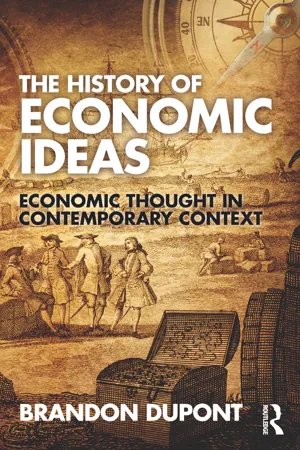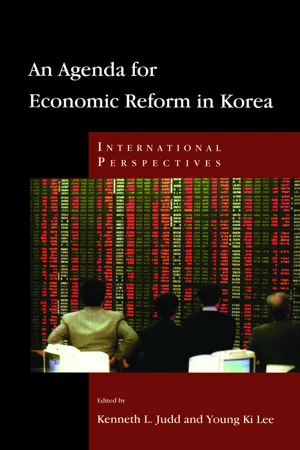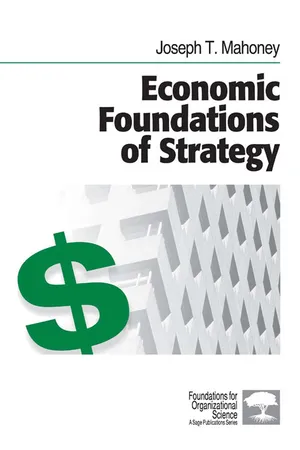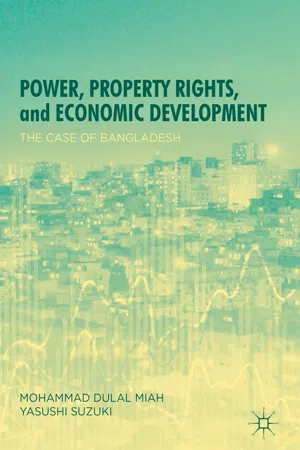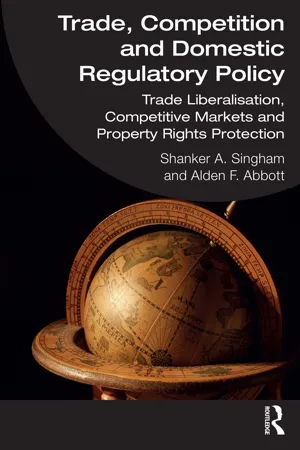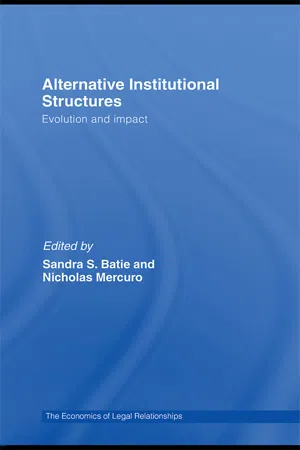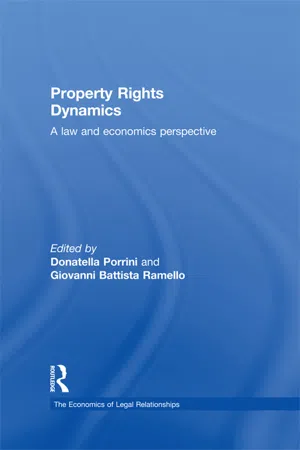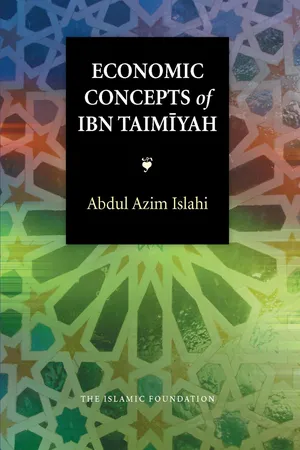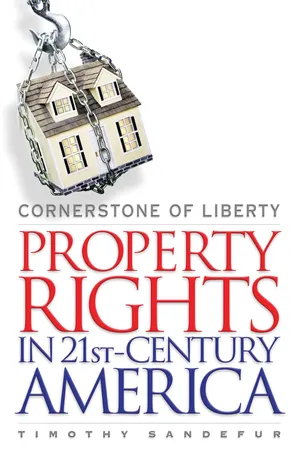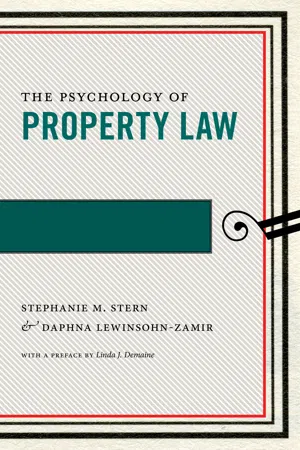Economics
Property Rights
Property rights refer to the legal ownership and control of resources, allowing individuals or entities to use, transfer, or exclude others from using their property. These rights are essential for promoting economic efficiency, incentivizing investment, and facilitating trade. Strong property rights provide individuals with the confidence to make long-term investments and use resources efficiently.
Written by Perlego with AI-assistance
Related key terms
11 Key excerpts on "Property Rights"
- eBook - ePub
The History of Economic Ideas
Economic Thought in Contemporary Context
- Brandon Dupont(Author)
- 2017(Publication Date)
- Routledge(Publisher)
3 Property Rights from Plato to the 21st Century“Thieves respect property. They merely wish the property to become their property that they may more perfectly respect it.” G. K. ChestertonChapter Overview
Property Rights are bundles of rights that determine who can legally use an asset or earn income from it. They constitute a set of rules that determine the extent of control and access to resources or goods and therefore specify who has the right to permanently transfer legal ownership to others. The right to private property is thus at the very heart of economic exchange, which involves the voluntary transfer of ownership of a set of Property Rights from a willing seller to a willing buyer. Understanding how individuals behave in a marketplace, given the constraints they face, requires that we first understand how the Property Rights rules affect those constraints. Since Property Rights affect incentives in important ways, economists generally believe that they are critically important for the process of economic growth and development. As Hernando DeSoto (2000) explained, “The formal property system is capital’s hydroelectric plant. This is the place where capital is born” (47). Specifying the rules that govern property is important, but efficiently enforcing those rules is equally important since “an individual has fewer rights over a commodity that is prone to theft or restrictions on its exchange” (Barzel 1997, 3).At a basic level, Property Rights can take four different forms: (1) private, (2) common, (3) open-access, or (4) public. For most of the historical scholarship we cover in this chapter, the distinction is simply between private and common property, so we will focus on those two broad types after defining these four forms.Private Property Rights - eBook - ePub
An Agenda for Economic Reform in Korea
International Perspectives
- Kenneth Judd, Young-Ki Lee(Authors)
- 2013(Publication Date)
- Hoover Institution Press(Publisher)
thing” (Fisher 1920, 27). Svetozar Pejovich defines the term in a similar way: “Property Rights specify the norms of behavior with respect to economic goods that all persons must observe in their interactions with other people or bear the penalty cost of non-observance” (Pejovich 1990, 27).To determine the implications of Property Rights on economic behavior and performance, one has to identify three aspects of the right of ownership: (1) the exclusivity of ownership, which means that the owner has the right to choose what to do with his assets; (2) the transferability of ownership, which means that the owner has the right to transfer his assets to others at mutually agreed upon terms; (3) a constitutional guarantee of ownership that separates economic wealth from political power. Exclusivity provides incentives for those who own assets to put them into the highest-valued uses, transferability provides incentives for resources to move from less-productive to more-productive owners, and the constitutional guarantee of ownership separates the accumulation of economic wealth from the accumulation of political power (Pejovich 1990, 28).On the other hand, in relation to the neoinstitutional approach emphasizing non-zero transaction costs, alternative Property Rights systems, for example, could have different effects on the size of transaction costs that the society should bear in resource allocation, and consequently also different effects on economic behavior and performance. The lack of a clear and secure system of Property Rights under the real world of non-zero transaction costs implies high transaction costs. If a secure and well-defined system of Property Rights does not exist, only physical power could be used to resolve conflicts over rights to economic resources, and therefore there would be no room for voluntary economic transactions to take place. In the absence of a well-defined system of Property Rights, transaction costs may be prohibitive, and will in turn inhibit voluntary transactions for optimal resource allocation. - eBook - ePub
- Joseph T. Mahoney(Author)
- 2004(Publication Date)
- SAGE Publications, Inc(Publisher)
In the 1990s, modern Property Rights theory (which provides more formalized mathematical models) has gained momentum in organizational economics, and Hart’s (1995) work is an exemplar of this modern Property Rights framework. With the increasing importance of intellectual Property Rights in our current information age (both early and modern), Property Rights theory predictably will receive greater attention in strategic management and may prove to spur a growth area for research in the years ahead.Contracting for Property Rights (Libecap, 1989)How do institutions evolve in response to individual economic incentives, strategies, and choices? Libecap (1989) emphasizes that Property Rights matter.1 Property Rights provide the basic economic incentive system that shapes resource allocation. What has been largely missing is why Property Rights take the form that they do. Libecap argues that Property Rights are formed and enforced by political entities and that Property Rights reflect the conflicting economic interests and bargaining strength of those affected. Moreover, because today’s choices are constrained by yesterday’s decisions, history matters.Property Rights are the social institutions that define or delimit the range of privileges granted to individuals of specific resources, such as parcels of land or water. Private ownership of these resources may involve a variety of Property Rights, including the right to exclude nonowners from access, the right to appropriate the stream of economic rents from use of and investments in the resource, and the rights to sell or otherwise transfer the resource to others. Property Rights institutions range from formal arrangements, including constitutional provisions, statutes, and judicial rulings, to informal conventions and customs regarding the allocations and uses of property. Such institutions critically affect decision making regarding resource use and, hence, affect economic behavior and economic performance. - eBook - ePub
Power, Property Rights, and Economic Development
The Case of Bangladesh
- Mohammad Dulal Miah, Yasushi Suzuki(Authors)
- 2018(Publication Date)
- Palgrave Macmillan(Publisher)
© The Author(s) 2018Begin AbstractPower, Property Rights, and Economic Development https://doi.org/10.1007/978-981-13-2763-6_2Mohammad Dulal Miah andYasushi Suzuki2. Theories of Property Rights: Transaction Cost and Beyond
End AbstractMohammad Dulal Miah1andYasushi Suzuki2(1) University of Nizwa, Birkat Al Mawz, Oman(2) Ritsumeikan Asia Pacific University, Beppu, JapanMohammad Dulal Miah (Corresponding author)Yasushi Suzuki2.1 Introduction
Property Rights define the rights that individuals or groups have to make decisions about the use to which specific assets may be put. They may include the right to use, to sell, to lease out, and to pass on to heirs, but usually preclude the right to use the asset in ways which explicitly hurt others. There are two basic and interrelated issues involved with the Property Rights analysis: right allocation and right enforcement. Each of them requires either voluntary cooperation from the non-owners of a property or a central enforcement authority. This idea of Property Rights has been brought to its current rigor by different branches of intellectual contribution, including philosophy , law, and economics . Following this tradition, this chapter attempts to briefly explain the salient contribution of these schools, which are essential for the analysis of Property Rights. We place a particular emphasis on philosophical contribution , new institutional , and institutional political economics.In the historical context, the importance of Property Rights was emphasized by the seventeenth-century philosophers, who were believed to have laid the basic foundation of property right analysis (Bethell 1999 ). Among others, Thomas Hobbes, John Locke, and Jean-Jacques Rousseau are prominent. Hobbes is important simply because his suggestion to establish a sovereign orleviathanwas mainly meant to protect properties from others’ expropriation . In his realization, without the state, protection of one’s property against others’ cruelty of expropriation depends on the might of the individual. Similarly, Locke provoked the most intense discussion, and controversies as well, about the idea of property. He acknowledged labor as the most sacred of all properties. Whatever men augment through their labor becomes their property, which men can preserve enough to maintain their subsistence level. In contrast, Rousseau criticized the role of civil society, which plays a guardian-like role in protecting private property . His criticism hinges on the assumption that the sovereign who rules the civil society enjoys the discretion to put his/her greed over the interest of the society. If so, the subsistence ethics - eBook - ePub
Trade, Competition and Domestic Regulatory Policy
Trade Liberalisation, Competitive Markets and Property Rights Protection
- Shanker A. Singham, Alden F. Abbott(Authors)
- 2023(Publication Date)
- Routledge(Publisher)
10 THE ROLE OF Property Rights IN BUILDING A COMPETITIVE MARKETDOI: 10.4324/9780429323331-10Property Rights are an indivisible part of the market economy whole – they are a leg of the three-legged stool that is required for a market economy to properly function. Working together, all of these elements – trade liberalisation, competitive markets and property right protections – can lift the poor out of poverty. A useful analogy, in terms of poverty reduction, is with a net which is used to catch fish. If one of these core elements is missing, this is akin to the fisherman fishing with a net with holes. In that case, any attempt by a government to lift its people out of poverty fails, as people are lost through the holes of the net. These issues are also foundational pillars on which a functioning market economy rests. A defect in one of the pillars will bring the structure down.The reason Property Rights are so important to a functioning economy is that they lead to a higher level of consumer welfare optimisation as Property Rights are the foundation upon which firms compete. Property Rights can therefore be said to support the many different platforms which are the basis of competition. These rights therefore underpin the process of market competition.We have noted that Property Rights play a fundamental role in building a competitive market economy. However, Property Rights are much deeper even than this. Property Rights have long been regarded as one of the essential rights of man. As such, the property right is an economic right, one of the rafts of economic rights in a bundle of so-called basic human rights. The right to the peaceful enjoyment of one’s property and the right to exclude others from it is one of the most fundamental of these basic rights. As early as moral philosophers Locke, Grotius and Pufendorf, the notion that the property right was a fundamental economic right has been enshrined as a basic tenet of moral and international laws. John Locke (in his Second Treatise of Government (1689)) noted that - eBook - ePub
Alternative Institutional Structures
Evolution and impact
- Sandra Batie, Nicholas Mercuro(Authors)
- 2008(Publication Date)
- Routledge(Publisher)
In order to understand the role of insecure Property Rights in promoting economic development, we apply Schmid’s basic insight – sometimes property is excessively secure – into understanding the relative economic performances of Great Britain in the years prior and following the Glorious Revolution, France in the decades before and after the French Revolution, and the United States from independence to the Civil War. In each instance, reforms moved the level of insecure Property Rights closer to their optimal level. In response, economic growth occurred. The tumultuous seventeenth century in Britain and the consequences of the French Revolution ushered in new institutions that affected the security of Property Rights. Excessively certain Property Rights were replaced by a growth-enhancing level of insecurity. Later, in the United States, Property Rights evolved in response to the expansion of territory and the demands associated with settlement.North and Thomas (1973) and Acemoglu et al. (2004) provided historical and econometric evidence that stresses the security of Property Rights as a fundamental determinant of comparative economic performance, especially in explaining the rise of the West. Hernando De Soto (2000) provides a similar explanation for the rise of the United States in the nineteenth century. However, their explanation requires revision to better understand the role of insecure Property Rights. We begin by re-examining the common assessment of the relationship between secure Property Rights and economic development.Property Rights and economic development
The search for the “deep” sources of economic growth and development has focused on the role of investments in human and physical capital that increase productivity. Investment in wealth-creating human and physical capital forms the core of economic development. Individuals allocate scarce resources so as to maximize their rates of return to their investments. Over time, they accumulate capital which increases their wealth creating capabilities. However, the emphasis on the incentives for human and physical capital accumulation has not always been central to explaining the sources of economic development.After World War II, secure Property Rights disappeared from discussions regarding economic development. Instead, variations of planning models that focused on factors such as strategic complementarities and forward and backward linkages across sectors offered explanations for underdevelopment. More broadly, traditional forms of market failures such as missing markets and pervasive externalities plagued developing economies and prevented economic takeoff. National governments, with assistance from international development agencies, would correct these problems with financial support and technical assistance. Economic development would follow. Discussions about the role of the security of Property Rights in human and physical capital accumulation rarely occurred. - eBook - ePub
Property Rights Dynamics
A Law and Economics Perspective
- Donatella Porrini, Giovanni Ramello, Donatella Porrini, Giovanni Ramello(Authors)
- 2012(Publication Date)
- Routledge(Publisher)
The institution of property is nearly as old as recorded history. In spite of its stability as a fundamental institution of human society, the concept of property and the privileges, obligations and restrictions that govern ownership have undergone substantial change throughout history.The history of property is illuminated by economic theory. The concept of scarcity – which some notable authorities believe is at least a necessary condition for the establishment of enforceable Property Rights – is valuable in explaining the limited domain of property in early societies and the changing contours of property protection as a result of changes in the economic structure of society.3 As pointed out by Demsetz (1967), Property Rights develop to internalize externalities in the use of scarce resources. However, there are costs associated with the establishment of property. While scarcity may be necessary for giving objects value and prompting the desire to have Property Rights, the establishment of such rights also requires that their protection be economically efficient from a societal standpoint, in the sense that the marginal benefit of protection (internalization) exceeds the marginal cost of protection. Property Rights emerge only when the gains of internalization become larger than the cost of internalization. The study of the historical evolution of property confirms these economic propositions and reveals that changes in the economy often trigger changes in the social and legal conception of property.4A large number of anthropologists and legal historians have come to agree on the identification of some general patterns in the evolution of property, as I shall now describe.Hunters and shepherds: the rise of functional propertyThe age of hunters was perhaps one of the first stages in which humans appeared to assert property claims over physical resources. In a hunter’s society, property consisted mostly of what hunters could kill for their own consumption or trade. At this stage, there was no need to define Property Rights over other resources, such as land or stock of wild animals and consequently little need for institutional protection of Property Rights. - eBook - ePub
- Abdul Azim Islahi(Author)
- 2015(Publication Date)
- The Islamic Foundation(Publisher)
CHAPTER IV Ibn Taimī yah on Property RightProperty right is an age-old human problem. The diversity of economic systems can be traced back to the diversity of approaches to the right to property. Such questions as whether there should be absolute private ownership, or absolute state ownership, or something in between as in the mixed economy, or some altogether different type of ownership, cannot be ignored by any economist.But property, in an absolute sense of the word, is not unique to man. In the words of Ernest Beaglehole: ‘In an unqualified usage of the term, property appears to be characteristic of many forms of animal life, with the important distinction, however, that one should only talk of property rights when the control of scarce objects can be related to a unique normative system of values; such a system is found only in human groups … Only in man can we postulate the emergence of a sense of selfhood that gives psychological underpinning for the concept of rights, duties, responsibilities and obligations.’1 Because of this ‘sense of selfhood’ there is a range of conflicts and divergences between individuals and groups. To resolve the matter of property right is a delicate task that has tried the thinkers of every age.A. Concept of property right in different systems1. Property right in Roman lawBecause of its relevance to our time, the institution of property under Roman law deserves to be considered first among the ancient systems. Its main characteristic was ‘a rigid and indeed somewhat harsh individualism. The Roman jurists had the prevailing tendency to consider that each citizen had the right to do what he liked with his own property, that the conception of private property necessarily included the right not merely to enjoy, but also arbitrarily to abuse and destroy, and logically likewise an untrammelled right of bequest. Here, in the two great principles of private property and complete freedom of contract, the Romans left a bias towards unfettered and irresponsible individualism as against the possible claim of the family, the sect, or the nation.’2 Even in the present age scholars have generally defined property on the Roman legal pattern. For example, defining property or dominion, John Austin says: ‘Taken with its strict sense it denotes a right – indefinite in point of use – unrestricted in point of disposition – and unlimited in point of duration – over a determinate thing.’3 - eBook - ePub
Cornerstone of Liberty
Property Rights in 21st Century America
- Timothy Sandefur(Author)
- 2006(Publication Date)
- Cato Institute(Publisher)
Property is the practical way of implementing the idea of self-ownership. For Master Hugh to take his earnings away meant that Hugh had the right to take away his labor, which means his body and his liberty, against his will. As Abraham Lincoln put it, slavery was simply “the same old serpent that says you work and I eat, you toil and I will enjoy the fruits of it.” 55 Almost two centuries before Douglass escaped from slavery, the English political philosopher John Locke had explained the principle of self-ownership in his Second Treatise of Civil Government. God had created man and then put each person in control of his or her own destiny, within certain natural boundaries. “Every man has a property in his own person,” he wrote. “This nobody has any right to but himself. The labor of his body, and the work of his hands, we may say, are properly his.” 56 For someone else—or for a group of people— to deprive a person of the product of his labor would be, so to speak, stealing that person from himself and from God. The legislature “is not, nor can possibly be, absolutely arbitrary over the lives and fortunes of the people,” because it only has “the joint power of every member of the society.” 57 And since nobody can have the right to deprive another person of what he or she has earned, nobody can transfer such authority to the government. Each person is in charge of his own life and the fruits of his labor; the government exists simply to ensure that people respect each other’s rights. Property Rights thus build a sphere of privacy around a person, within which he or she is free to act without anyone else interfering: a realm of personal dominion where people may make their own choices. Property Rights minimize the degree to which people may use force against each other and require them to deal with one another on the basis of mutual respect, deliberation, and cooperation. This increases their freedom - eBook - ePub
Private Property and the Constitution
State Powers, Public Rights, and Economic Liberties
- James Huffman(Author)
- 2013(Publication Date)
- Palgrave Macmillan(Publisher)
Household Finance Co., a property right is “no less than the right to speak or the right to travel, … in truth a ‘personal’ right.” “Property does not have rights,” said Justice Stewart, “[p]eople have rights.” 19 The attributes of constitutionally guaranteed Property Rights are also what give property economic value. But as critics of market resource allocation invariably point out, not all values can be measured in dollars and cents. No one begins to imagine that compensation for lives lost or liberty denied fully repairs the harm done. Even when compensation is paid for pain and suffering, we know it is a rough approximation, at best, for harms that are really immeasurable in economic terms. When damages are paid in a wrongful death action or compensation is paid to an individual wrongfully imprisoned by the state, no one doubts that irreparable harm remains. The constitution’s several guarantees of Property Rights make clear that compensation for property taken often leaves personal injury without remedy. There is no better demonstration of this deeply personal nature of Property Rights than the popular reaction to the Kelo case discussed in Chapter 2 of the companion volume, Property Rights and State Power. The City of New London could pay Susette Kelo the market value of her land, or much more than the market value, but by forcing her to sell the City nonetheless intruded upon her personal freedom in a way that a large majority of Americans found deeply offensive. Where the interests of the community warrant the taking of life and liberty, insistence on due process is the best we can do. Where community interests warrant the taking of private property, we have the good fortune to be able to mitigate the loss by financial compensation - eBook - ePub
- Stephanie M. Stern, Daphna Lewinsohn-Zamir(Authors)
- 2020(Publication Date)
- NYU Press(Publisher)
Admittedly, there may be countervailing considerations against adopting people’s perceptions and preferences in this regard. Take, for instance, a person who is not willing to sell her land for any price, or who values it at three time its market price. Even when no strategic behavior is involved, catering to such intense preferences is problematic. It seems unfair to favor these individuals over those who exhibit more “ordinary” intensities, when choosing the location of public projects and spending from the government’s limited budget (for a general discussion of intense preferences, see Lewinsohn-Zamir 2009). Thus, the unwillingness to satisfy excessive idiosyncratic preferences (Lee 2013, 620–25), the high administrative costs of tailoring compensation rules, and the fear that too high compensation levels will stymie socially beneficial development or impede political resistance to questionable projects (Garnett 2006, 138–43) may constrain the magnitude of increased takings compensation. However, if one holds that enhancing human welfare is a central goal of legal policy making, and if one espouses a theory of welfare that is concerned with preference fulfillment, it is important to be aware of the flaws of current compensation rules—and particularly their underestimation of “ordinary” property and assets used for commercial or investment purposes. The conflicting considerations discussed in this section justify placing a ceiling on the percentage by which compensation can exceed market prices. One can view such a ceiling as setting the limits to the socially acceptable valuation of land.Passage contains an image
4
Redistribution through Property Law
Worldwide, many people agree that promoting equality in society should be a central governmental concern. Reducing gross inequalities between individuals may be viewed as good in and of itself, or as a means to ensure that every person enjoys an adequate level of welfare. Property is commonly regarded as essential for attaining this goal. Thus, for instance, theoreticians have claimed that the ability to decide for oneself and to act according to one’s choices, as well as the freedom from interference and coercion of others, require ownership of sufficient property. Without enough material goods to guarantee both physical and mental health, personal independence and autonomous action are impossible. Similarly, lack of security in one’s present or future condition significantly reduces the possibility of free choice. Property ownership assures us the enjoyment of assets (such as the home and household goods) through which we draw a protective boundary between ourselves and the rest of the world, including the state. Consequently, property enables us to attain and retain our capabilities to act, develop self-respect and aspirations, and maintain our independently chosen beliefs and convictions (Harris 1996, 303–05; Rawls 1993, 298; Reich 1964, 771; A. Sen 1992, 39–55).Private property promotes additional values besides autonomy and liberty. Material resources enable individuals to acquire knowledge about themselves and about the world, to adopt and realize long-terms goals, and to fulfill their potential. Furthermore, the various items of property and their many uses constitute an important source of pleasure (for discussion of the importance of property for enhancing people’s well-being, see Lewinsohn-Zamir 2003). In sum, a certain amount of property is necessary for people to be able to fare even modestly well. Property surpassing this minimum can raise people’s well-being by affording them greater freedom from others, more opportunities for acquiring knowledge, additional means for pursuing long-term goals, and more possibilities for enjoyment.1
Index pages curate the most relevant extracts from our library of academic textbooks. They’ve been created using an in-house natural language model (NLM), each adding context and meaning to key research topics.
